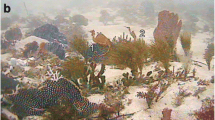Abstract
Underwater observations of two living individuals and an examination of a freshly dead individual of the rare deep-sea fish Triodon macropterus revealed that they usually have the large ventral flap completely uplifted and seamlessly retracted into the abdominal region of the trunk: one individual was collected at a depth of 280 m by hook and line east of Tonaki-jima Island, Ryukyu Islands, and kept in a tank at the Okinawa Churaumi Aquarium for six years; the second living individual was observed by the ROV Hakuyo 2000 at a depth of 275 m east of Ishigaki-jima Island, Ryukyu Islands; and another individual collected at depths of 250−350 m by hook and line off Funchu Point, Yoron-jima Island (27°00.15’N, 128°26.06’E), Ryukyu Islands, provided an opportunity to demonstrate that the ventral flap could be manually uplifted by rotating the pelvis. When the ventral flap was uplifted in all of these specimens, whether naturally or manually, there were no scaleless linear bands or streaks and gaps evident in the skin between the retracted ventral flap and the abdominal region. The fine structure of the scales of the body and the ventral flap was observed by light microscopy, scanning electron microscopy, and X-ray CT scanning. The scales of the ventral flap are arranged in rows radiating from the antero-dorsal part of the ventral flap where the anterior part of the pelvis articulates with and rotates around the pectoral girdles. The orientation of the rows on the ventral flap changes from a posterior direction dorsally to a posteroventral direction more ventrally. A ridge with many sharp serrations is raised and bent from the edge of each scale on the body and ventral flap. The raised ridges on the lower scales on the ventral flap become packed together with the upper scales to form a seamless surface when the ventral flap is uplifted into the abdominal region.








Similar content being viewed by others
References
Arcila D, Pyron RA, Tyler JC, Ortí G, Betancur-R R (2014) An evaluation of fossil tip-dating versus node-age calibrations in tetraodontiform fishes (Teleostei: Percomorphaceae) Mol Phylogenet Evol 82:131–145
Britz R, Johnson GD (2012) The caudal skeleton of a 20 mm Triodon and homology of its components. Proc Biol Soc Wash 125:66–73
Conway KW, Lujan N, Lundberg JG, Mayden RL, Siegel DS (2012) Microanatomy of the paired-fin pads of ostariophysan fishes (Teleostei: Ostariophysi). J Morphol 273: 1127–1149
Matsuura K (2015) Taxonomy and systematics of tetraodontiform fishes: a review focusing primarily on progresses in the period from 1980 to 2014. Ichthyol Res 62:72−113
Matsuura K, Tyler JC (1997) Tetraodontiform fishes, mostly from deep waters, of New Caledonia. No. 9. In: Séret B (ed) Résultats des Campagnes MUSORSTOM, 17. Mem Mus Natl Hist Nat, Paris (NS) (Sér A) Zool 174:173−208
Near TJ, Dornburg A, Eytana RI, Keck BP, Smith WL, Kuhn KL, Moore JA, Price SA, Burbrink FT, Friedman M, Wainwright PC (2013) Phylogeny and tempo of diversification in the superradiation of spiny-rayed fishes. PNAS 110:12738−12743
Tyler JC (1967) A redescription of Triodon macropterus Lesson, a phyletically important plectognath fish. Proc K Ned Akad Wet Ser C, Biol Med Sci 70:84–96
Tyler JC (1980) Osteology, phylogeny, and higher classification of the fishes of the order Plectognathi (Tetraodontiformes). NOAA Tech Rep NMFS CIRC 434:1–422
Yamanoue Y, Miya M, Matsuura K, Katoh M, Sakai H, Nishida M (2008) A new perspective on phylogeny and evolution of tetraodontiform fishes (Pisces: Acanthopterygii) based on whole mitochondrial genome sequences: basal ecological diversification? BMC Evol Biol 8:212
Acknowledgments
We thank Hiromitsu Endo and Naohide Nakayama (BSKU), Toshio Kawai (HUMZ), and Hiroyuki Motomura (KAUM) for giving us permission to examine the specimens of Triodon macropterus under their care. We thank the Fukada Salvage and Marine Works Co., Ltd., for providing us a short underwater movie of T. macropterus. James C. Tyler and Edward O. Murdy provided helpful comments on the manuscript. Harutaka Hata (KAUM) provided useful information of the Yoron-jima individual. An X-ray photograph of T. macropterus (NSMT-P 93783) was taken by Kaoru Kuriiwa (NSMT). This study was partially supported by JSPS KAKENHI Grant Number JP 24120001 in Scientific Research on Innovative Areas entitled “Innovative Materials Engineering Based on Biological Diversity”, Health Labour Sciences Research Grant (FY2015–2017) of the Ministry of Health, Labour and Welfare, Japan, and JSPS Asian Core Program “Establishment of Research and Education Network on Coastal Marine Science in Southeast Asia.”
Author information
Authors and Affiliations
Corresponding author
About this article
Cite this article
Matsuura, K., Kaneko, A. & Katayama, E. Underwater observations of the rare deep-sea fish Triodon macropterus (Actinopterygii, Tetraodontiformes, Triodontidae), with comments on the fine structure of the scales. Ichthyol Res 64, 190–196 (2017). https://doi.org/10.1007/s10228-016-0555-2
Received:
Revised:
Accepted:
Published:
Issue Date:
DOI: https://doi.org/10.1007/s10228-016-0555-2




